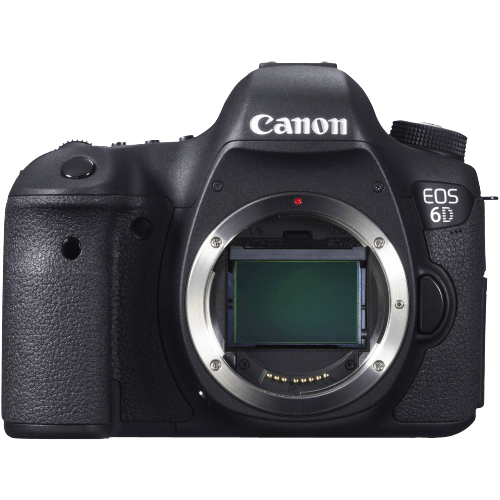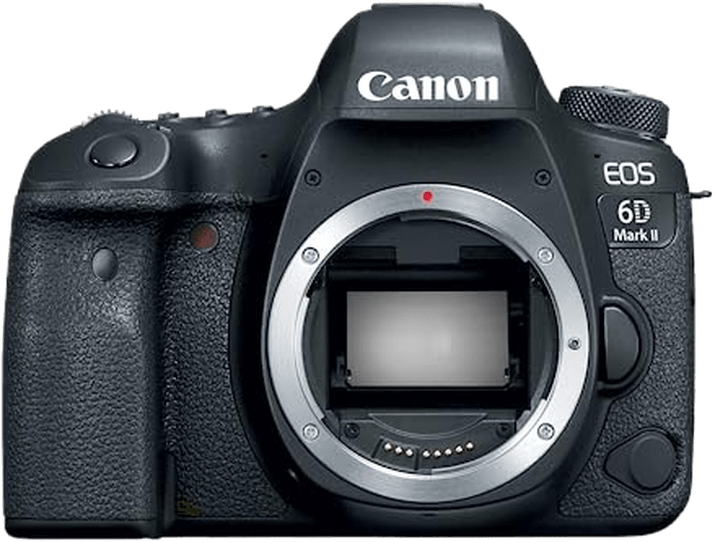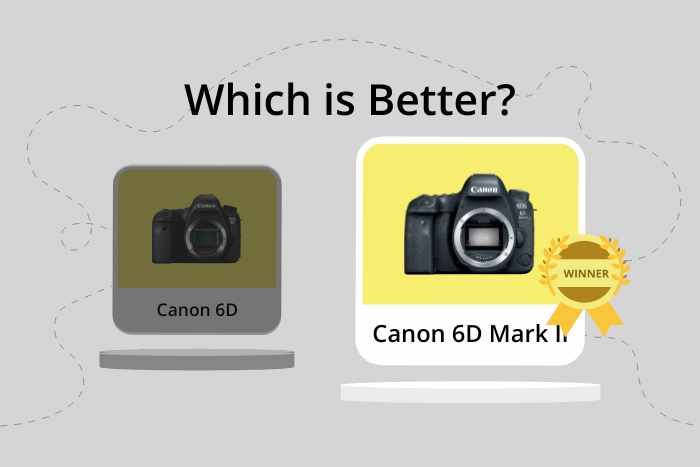Canon EOS 6D vs EOS 6D Mark II Comparison
Canon EOS 6D

Canon EOS 6D Mark II

The Canon EOS 6D Mark II takes the lead with a score of 71/100, while the Canon EOS 6D lags behind at 59/100. Both cameras are DSLR models, announced in 2012 and 2017 respectively. They share similar dimensions, with the 6D measuring 145 x 111 x 71mm and the 6D Mark II at 144 x 111 x 75mm.
The 6D Mark II edges out its predecessor with a lower launch price of $2000 compared to the 6D’s $2099. Furthermore, the 6D Mark II is significantly lighter, weighing only 453g compared to the 6D’s 770g. This makes the 6D Mark II more portable and user-friendly.
On the other hand, the 6D has a slightly slimmer profile, which could be a minor advantage for some users. However, considering the overall score and other specifications, the Canon EOS 6D Mark II is the better choice for most photographers, offering improved features and better value for money.
Canon EOS 6D vs EOS 6D Mark II Overview and Optics
The Canon EOS 6D Mark II takes the lead in optics with a score of 69/100, while the Canon EOS 6D trails behind with a score of 61/100. Both cameras share several key specifications, including a full-frame CMOS sensor, Canon EF lens mount, and lack of image stabilization.
The EOS 6D Mark II outperforms its predecessor in several aspects. With 26.2 megapixels, it offers a higher resolution than the EOS 6D’s 20.2 megapixels, resulting in more detailed images. The EOS 6D Mark II also boasts a faster shooting speed of 6.5 frames per second (fps), compared to the EOS 6D’s 4.5 fps, allowing for better capture of fast-moving subjects. Additionally, the Mark II features an upgraded Digic 7 processor, contributing to its improved performance. Lastly, the EOS 6D Mark II has a higher DXOMARK score of 85 for its sensor, compared to the EOS 6D’s score of 82, signifying better overall image quality.
The Canon EOS 6D, on the other hand, does not offer any significant advantages over the EOS 6D Mark II in terms of optics. Both cameras have the same sensor size, lens mount, and lack of image stabilization, leaving the EOS 6D at a disadvantage with its lower megapixel count, slower shooting speed, and older processor.
Considering these factors, the Canon EOS 6D Mark II emerges as the superior camera in terms of optics, with its higher resolution, faster shooting speed, and better sensor performance. The EOS 6D, while still a capable camera, falls short when compared to its successor, making the EOS 6D Mark II a more attractive option for photographers seeking improved optical performance.
Canon EOS 6D vs EOS 6D Mark II Video Performance
The Canon EOS 6D Mark II outperforms the Canon EOS 6D in video capabilities, with a video score of 57 out of 100 compared to the EOS 6D’s score of 43. Both cameras share some common specifications, such as Full HD video resolution, maximum video dimensions of 1920 x 1080, and a maximum video frame rate of 30fps. However, there are notable differences that make the EOS 6D Mark II the superior choice for video.
The EOS 6D Mark II’s advantage lies in its built-in time-lapse functionality, which the EOS 6D lacks. This feature allows the EOS 6D Mark II to capture a series of images over a period of time and combine them into a seamless video, providing a unique perspective of changing scenes. This is particularly useful for capturing events such as sunsets, cityscapes, or nature scenes, giving the EOS 6D Mark II an edge in versatility.
On the other hand, the EOS 6D does not offer any specific advantages in video capabilities over the EOS 6D Mark II. Both cameras have the same video resolution, dimensions, and frame rate, but the EOS 6D falls short due to its lack of time-lapse functionality.
In comparing the video capabilities of the Canon EOS 6D and EOS 6D Mark II, it is clear that the EOS 6D Mark II offers greater functionality and versatility with its built-in time-lapse feature. While the EOS 6D shares some common specifications with the EOS 6D Mark II, it does not excel in any particular aspect of video capture. Therefore, the EOS 6D Mark II is the superior choice for users seeking enhanced video capabilities in their camera.
Canon EOS 6D vs EOS 6D Mark II Features and Benefits
The Canon EOS 6D Mark II triumphs over the Canon EOS 6D with a feature score of 83/100 compared to the latter’s 57/100. Both cameras share some common specifications: a 3-inch screen size, a screen resolution of 1,040,000 dots, GPS, and WIFI capabilities.
The 6D Mark II outperforms the 6D in several aspects. Firstly, it has a touchscreen, which allows for easier navigation and control. Secondly, it features a flip screen, making it convenient for capturing images from various angles and enhancing the user’s overall shooting experience. Lastly, the 6D Mark II has Bluetooth connectivity, providing additional options for transferring files and controlling the camera remotely.
While the Canon EOS 6D lags behind the 6D Mark II in terms of features, it still retains some advantages. For instance, its GPS and WIFI capabilities enable geotagging and wireless file transfer, respectively. However, these features are also present in the 6D Mark II, making it difficult to argue that the EOS 6D is superior in any specific aspect.
To conclude, the Canon EOS 6D Mark II stands out as the better choice between the two cameras due to its higher feature score and additional offerings such as a touchscreen, flip screen, and Bluetooth connectivity. The Canon EOS 6D, though sharing some similarities with the 6D Mark II, falls short in comparison and does not offer any unique advantages.
Canon EOS 6D vs EOS 6D Mark II Storage and Battery
The Canon EOS 6D and Canon EOS 6D Mark II both score 45/100 in storage and battery. They share similarities in this aspect, such as having one memory card slot and accepting SD, SDHC, and SDXC memory cards. Neither camera has USB charging capabilities.
The Canon EOS 6D Mark II holds an advantage in battery life and memory card compatibility. With 1200 shots per charge, it surpasses the Canon EOS 6D, which provides 1090 shots. The 6D Mark II also supports faster UHS-I compatible memory cards, allowing for quicker data transfer.
The Canon EOS 6D, however, does not have any specific advantages in this category. Both cameras use similar battery types, with the 6D using the LP-E6 and the 6D Mark II using the LP-E6N.
Considering their storage and battery capabilities, the Canon EOS 6D Mark II has a slight edge due to its longer battery life and better memory card compatibility. The Canon EOS 6D, while not having any distinct advantages in this area, still maintains a solid performance in terms of storage and battery.
Canon EOS 6D vs EOS 6D Mark II Alternatives
Still not ready to make a decision? Check out our other popular camera comparisons for inspiration:

